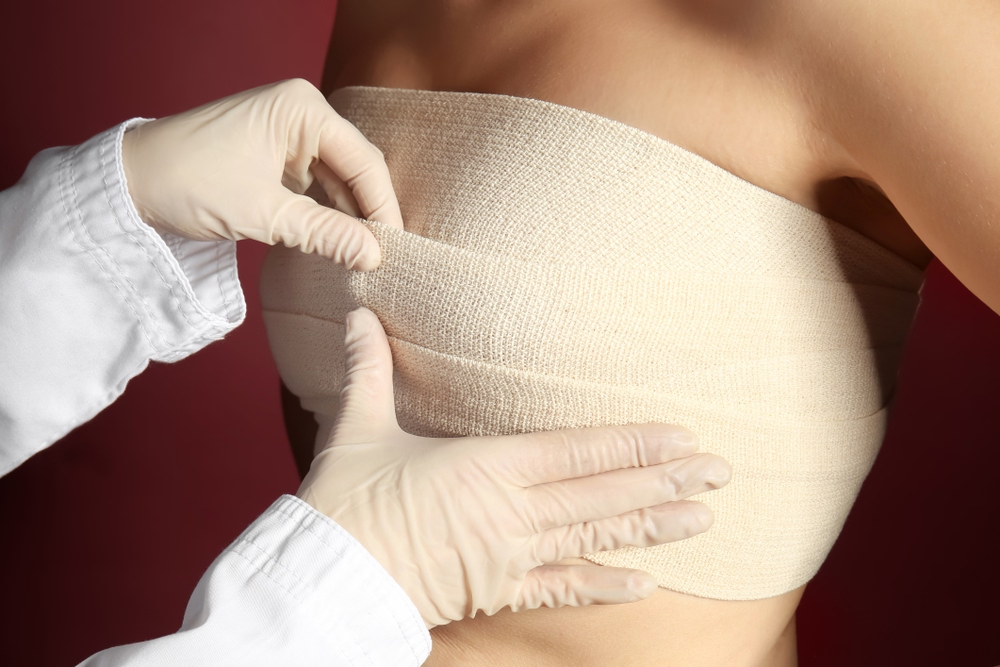Anticipating the transformative journey of breast augmentation implants can stir a mix of excitement and concern about the recovery phase. Dr. Paul Vitenas, renowned for his empathetic approach and expertise, provides a reassuring guide through the nuances of post-operative pain. With a focus on patient well-being, Dr. Vitenas offers personalized insights, differentiating between common discomforts and potential concerns. His thoughtful guidance not only demystifies the post-augmentation pain experience but also ensures a smoother, more comfortable healing process tailored to each individual’s unique needs.

Understanding Post-Operative Pain in Breast Augmentation
Experiencing pain after breast augmentation surgery is a common aspect of the healing process. This discomfort can vary in intensity, depending on the type of surgery and the individual’s pain threshold. Breast Augmentation patients typically report pain around the chest area as the skin adjusts to the breast implants.
As the body acclimates to the new implants, the pain should gradually subside. Proper care and following post-surgery instructions can greatly aid in managing this pain, ensuring a smoother recovery trajectory. Pain management strategies will be discussed in detail, ensuring patients are well-informed and prepared for the post-operative journey.
Identifying Normal Post-Surgical Symptoms
Mild to Moderate Discomfort
After surgery, experiencing mild to moderate discomfort is typical. It’s your body’s natural response. You’re likely to feel pain at the incision site or in surrounding areas, especially if the surgery involved breast tissue. Managing this discomfort is crucial for your healing process. We usually prescribe over-the-counter or prescription pain relievers to help ease this discomfort.
Swelling and Bruising Presence
Swelling is another common symptom post-surgery, occurring as part of the body’s healing process. In procedures involving breast tissue, this swelling can be more pronounced and may take weeks to subside. Bruising can also appear around the operated area, signaling that your body is mending. Both swelling and bruising should gradually improve over time.
Sensitivity and Sensation Changes
Changes in sensitivity or sensation are to be expected after surgery. The operated area, particularly breast tissue, may feel numb, overly sensitive, or have a tingling sensation. These changes can result from nerve irritation or damage during surgery and usually resolve as the nerves regenerate during the healing process. However, it’s essential to monitor these changes and report any concerns to your surgeon.
Managing Expected Pain
Proper Use of Prescribed Medications
For effective pain relief, it’s crucial to follow Dr. Vitenas’s instructions when it comes to prescribed medications. Start by taking pain medications before the discomfort becomes too intense, as this can make it harder to manage. Adhere to dosing schedules carefully to maintain steady pain control and avoid overuse, which can cause side effects or dependency.
Techniques for Minimizing Swelling
Reducing swelling is vital for recovery, and there are several strategies to achieve this:
- Elevate the affected area to decrease fluid accumulation.
- Apply cold packs intermittently in the first 24-48 hours post-surgery, following a schedule recommended by your surgeon.
- Maintain gentle movement in adjacent joints to promote circulation as long as it does not exacerbate pain.
Importance of Rest and Recovery
Remember, rest is a cornerstone of breast augmentation recovery. Allocate time for your body to heal without engaging in strenuous activities that may intensify pain or swelling. Adequate sleep and relaxation are essential to allow your body’s natural healing processes to proceed undisturbed. It’s a delicate balance—while some movement aids in circulation and healing, too much activity can be detrimental to your recovery trajectory.
Differentiating Between Common Pain and Complications
Red Flags in Post-Surgery Pain
While some discomfort after surgery is normal, certain types of pain should prompt immediate attention. Sharp, persistent pain that doesn’t subside with prescribed treatments can be a red flag. If pain around your breast implants intensifies or spreads, it may signal a problem beyond the usual recovery process aches.
Symptoms of Infection or Implant Issues
Infections can cause tenderness, redness, and swelling that escalate rather than improve over time. Unusual discharge or an increase in skin temperature near the surgical site can also indicate an infection. For implant-specific complications, watch for changes in shape, breast size, or symmetry that weren’t present immediately after surgery. These could point to implant issues that require a surgeon’s intervention.
When to Contact Your Surgeon
Always consult your surgeon if you experience:
- Sudden, severe pain not relieved by medications.
- Signs of infection, such as persistent fever, chills, or unusual discharge.
- Any abnormal changes in the appearance of your implants.
If pain or symptoms persist despite following aftercare instructions, don’t hesitate; your surgeon can offer advice or recommend further treatments to ensure your safety and the success of your surgery.
Following a Tailored Pain Management Plan
Customizing Your Pain Relief Strategy
Crafting a pain relief strategy that aligns with your personal needs is crucial for effective healing. We map out a regimen that targets your specific pain points, incorporating medications, physical therapy, or alternative treatments. This individualized approach ensures that pain doesn’t hamper your recovery.
Recovery Timeline and Milestones
Understanding your recovery timeline is vital. Generally, significant improvements are noticeable within weeks, setting expectations for both short and long-term healing goals. Regular assessments help track progress, allowing us to adjust your pain management plan to align with your healing process.
Utilizing Non-Medication Pain Relief Methods
Gentle Exercises and Mobility
Engaging in gentle exercises can enhance mobility and alleviate pain, especially in areas such as the chest muscles. Simple stretching can increase flexibility, promote healing, and reduce tension. Walking and tai chi are excellent options that care for the body’s need for activity without exacerbating pain. Encouraging movement helps to keep the chest muscles limber, supporting overall comfort and pain management.
Cold Compresses and Heat Therapy
Cold compresses can help reduce inflammation and numb sore tissues, providing temporary relief. Applying ice packs to painful areas for short periods may diminish discomfort in the chest muscles. Conversely, heat therapy has its place in soothing stiff muscles and joints. A warm bath or a heating pad can ease muscle pain by enhancing circulation and relaxing the muscle fibers.
Keeping a Pain Diary
Tracking your progress is essential when managing pain. We make it simple by recommending a pain diary. Note daily pain levels and describe the pain’s nature—sharp, dull, throbbing. This record helps you and your healthcare provider gauge your healing and tailor your pain management plan.
Understanding the Healing Process
Healing is a journey your body embarks on the moment an injury occurs. Recognizing the phases of healing ensures expectations remain realistic. Inflammation marks the beginning, followed by tissue repair and, finally, remodeling. Each stage must unfold at its own pace; understanding this supports patience with your body’s timeline.
Preparing for Follow-Up Appointments
What to Expect During Check-Ups
In the weeks after surgery, your surgeon will schedule follow-up appointments to monitor your recovery. During these check-ups, expect a thorough evaluation of your surgical site for healing and potential complications. Your surgeon may order imaging tests or blood work to ensure everything is on track. These appointments are also an opportunity to discuss any new symptoms or concerns you might have.
Discussing Pain and Concerns with Your Surgeon
It’s vital to be open with your plastic surgeon about any pain you experience. A detailed account of your pain helps the plastic surgeon tailor your care and address potential issues early on. Don’t hesitate to describe the intensity, frequency, and location of pain. This dialogue is key to managing your discomfort effectively and adjusting your pain management plan if necessary.
Long-Term Care and Observations
Long-term care involves continuous attention to your health and well-being. Your surgeon will provide guidance on physical activities, lifestyle adjustments, and possible long-term observations to ensure a successful recovery. It’s crucial to maintain all follow-up appointments, as ongoing surveillance can detect delayed complications or signs of recurrence that are pivotal to address promptly.
Breast Augmentation Before & After Photos
Diet and Nutrition for Recovery
An optimal diet promotes faster recovery. Foods rich in protein, vitamins, and minerals support your body’s repair process. Concentrate on:
- Lean meats, beans, and nuts to provide the protein necessary for tissue repair.
- Fruits and vegetables rich in antioxidants to reduce inflammation.
- Whole grains to maintain energy levels and support blood circulation.
In the weeks after surgery, your body requires extra nutrients to heal. Ensure you’re getting a balanced diet.
Tips for Sleeping and Comfort
After surgery, restful sleep can sometimes be a challenge due to discomfort and changes in routine. Here are a few tips to improve sleep quality:
- Elevate the affected area if advised to help with blood circulation and reduce swelling.
- Use a supportive mattress and pillows to align your body comfortably.
- Maintain a consistent sleep schedule even if you’re not active during the day.
Good sleep is essential, so prioritize creating a relaxing environment. Allow yourself the rest you need as your body heals, especially in the weeks following surgery.
Managing Pain After Breast Augmentation
Pain management is crucial post-breast augmentation surgery, and adherence to your surgeon’s prescribed medication is key for a comfortable recovery. Swelling is normal, and your surgeon may suggest ice packs and specific postures to minimize it. Creating a cozy recovery space at home is beneficial as your body adjusts to the changes. While some discomfort is anticipated, understanding when to seek professional advice is essential. Dr. Paul Vitenas’s expertise in postoperative care ensures personalized guidance for a smooth recovery.
If you’re experiencing pain or simply have questions about your recovery, don’t hesitate to schedule a consultation with Dr. Vitenas. Your well-being is our top priority, and together, we’ll help you manage pain effectively on your journey to feeling your best.


